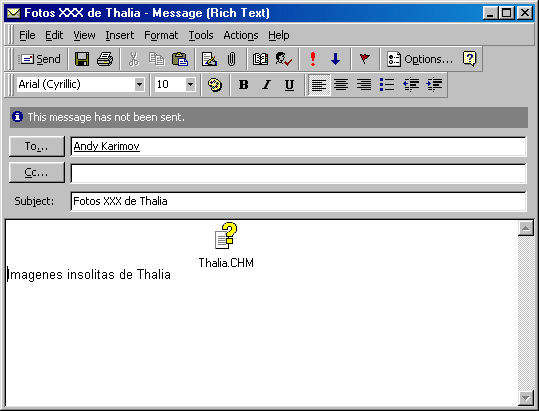Parent class: VirWare
Viruses and worms are malicious programs that self-replicate on computers or via computer networks without the user being aware; each subsequent copy of such malicious programs is also able to self-replicate. Malicious programs which spread via networks or infect remote machines when commanded to do so by the “owner” (e.g. Backdoors) or programs that create multiple copies that are unable to self-replicate are not part of the Viruses and Worms subclass. The main characteristic used to determine whether or not a program is classified as a separate behaviour within the Viruses and Worms subclass is how the program propagates (i.e. how the malicious program spreads copies of itself via local or network resources.) Most known worms are spread as files sent as email attachments, via a link to a web or FTP resource, via a link sent in an ICQ or IRC message, via P2P file sharing networks etc. Some worms spread as network packets; these directly penetrate the computer memory, and the worm code is then activated. Worms use the following techniques to penetrate remote computers and launch copies of themselves: social engineering (for example, an email message suggesting the user opens an attached file), exploiting network configuration errors (such as copying to a fully accessible disk), and exploiting loopholes in operating system and application security. Viruses can be divided in accordance with the method used to infect a computer:- file viruses
- boot sector viruses
- macro viruses
- script viruses
Class: Email-Worm
Email-Worms spread via email. The worm sends a copy of itself as an attachment to an email message or a link to its file on a network resource (e.g. a URL to an infected file on a compromised website or a hacker-owned website). In the first case, the worm code activates when the infected attachment is opened (launched). In the second case, the code is activated when the link to the infected file is opened. In both case, the result is the same: the worm code is activated. Email-Worms use a range of methods to send infected emails. The most common are: using a direct connection to a SMTP server using the email directory built into the worm’s code using MS Outlook services using Windows MAPI functions. Email-Worms use a number of different sources to find email addresses to which infected emails will be sent: the address book in MS Outlook a WAB address database .txt files stored on the hard drive: the worm can identify which strings in text files are email addresses emails in the inbox (some Email-Worms even “reply” to emails found in the inbox) Many Email-Worms use more than one of the sources listed above. There are also other sources of email addresses, such as address books associated with web-based email services.Read more
Platform: VBS
Visual Basic Scripting Edition (VBScript) is a scripting language interpreted by Windows Script Host. VBScript is widely used to create scripts on Microsoft Windows operating systems.Description
Technical Details
Talorm is a worm virus spreading via the Internet as an attachment to infected emails and copies itself to IRC channels. The worm itself is a CHM file (compressed HTML file) about 17KB in length.Infected messages have the following features:
The Subject Line text is randomly selected from the following variants:
- Fotos de Thalia - Free Pics - Fotos XXX de Thalia - Fotos Exitantes de Thalia
The body text is randomly selected from the following variants:
- Checa estas fotos de Thalia - Hola que tal? ya viste las super fotos exitantes de Thalia - Como tas! aqui te mando unas fotos de Thalia - Para mis mejores Amigos fotos de Thalia - Fotos XXX de Thalia - unas fotos bien padres de Thalia - Imagenes insolitas de Thalia - Apuesto a que no has visto desnuda a Thalia - HOLA! TE RETO A CHECAR ESTAS FOTOS BIEN CHIDAS DE Thalia - Fotos Exitantes de la cantante Thalia Attach: Thalia.chm
An example of a "Talorm" email message:

The worm activates from infected emails only when a user clicks on the attached file. If this happens Talorm then installs itself to the system and runs its spreading routine.
The worm then overwrites a registry key with new text:
HKLMSoftwareMicrosoftWindowsCurrentVersion RegisteredOwner = Thalia"
and displays the message:
While installing the worm copies itself to the Windows directory with the "Thalia.chm" name and
registers this file in the system registry auto-run key:
To send infected messages the worm uses MS Outlook and sends messages to all addresses found in each victim machine's Outlook address book.
The worm looks for the mIRC subdirectory in the "Program Files" directory and writes a new "script.ini"
file to this location. This script file has instructions that send worm copies to every user who joins an infected IRC channel.
Find out the statistics of the vulnerabilities spreading in your region on statistics.securelist.com
Installing
HKLMSoftwareMicrosoftWindowsCurrentVersionRun
Thalia = %WinDir%Thalia.CHM
Spreading: EMail
Spreading: IRC
Read more